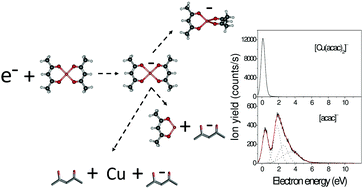当前位置:
X-MOL 学术
›
Phys. Chem. Chem. Phys.
›
论文详情
Our official English website, www.x-mol.net, welcomes your feedback! (Note: you will need to create a separate account there.)
Interaction of gas phase copper(ii) acetylacetonate with slow electrons†
Physical Chemistry Chemical Physics ( IF 3.3 ) Pub Date : 2018-03-05 00:00:00 , DOI: 10.1039/c7cp08149a Janina Kopyra 1, 2, 3, 4 , Franck Rabilloud 5, 6, 7, 8, 9 , Hassan Abdoul-Carime 5, 6, 7, 8, 9
Physical Chemistry Chemical Physics ( IF 3.3 ) Pub Date : 2018-03-05 00:00:00 , DOI: 10.1039/c7cp08149a Janina Kopyra 1, 2, 3, 4 , Franck Rabilloud 5, 6, 7, 8, 9 , Hassan Abdoul-Carime 5, 6, 7, 8, 9
Affiliation

|
Understanding the fundamental processes underlying the interaction of organometallic compounds with low energy electrons is desirable for optimizing methodologies for nanoscale applications. In this work, we couple experimental measurements with theories to investigate the interaction of gas phase copper(II) acetylacetonate, Cu(acac)2, with low energy (<12 eV) electrons. Near 0 eV, a multipole-bound anion is likely to act as the doorway for the formation of a transitory molecular anion which then undergoes stabilization via a 90°-rotation of one of the acac units. The production of the parent anion competes with the dissociation processes, generating preferentially the acetylacetonate negative ion. Moreover, at incident electron energies above 3.5 eV, the electron driven fragmentation of Cu(acac)2 is likely to produce atomic Cu. These results can suggest some potential strategies for the deposition of pure copper using an appropriate electron irradiation technique.
中文翻译:

气相乙酰丙酮铜(ii)与慢电子的相互作用†
了解有机金属化合物与低能电子相互作用的基本过程对于优化纳米级应用的方法学是理想的。在这项工作中,我们将实验测量与理论相结合,以研究气相乙酰丙酮铜(II),Cu(acac)2与低能(<12 eV)电子的相互作用。接近0 eV时,与多极结合的阴离子很可能充当瞬态分子阴离子形成的通道,然后该瞬态分子阴离子通过acac单元之一旋转90°。母体阴离子的产生与解离过程竞争,优先产生乙酰丙酮酸负离子。此外,在入射电子能量高于3.5 eV时,Cu(acac)2的电子驱动碎裂可能产生原子Cu。这些结果可能表明使用适当的电子辐照技术沉积纯铜的一些潜在策略。
更新日期:2018-03-05
中文翻译:

气相乙酰丙酮铜(ii)与慢电子的相互作用†
了解有机金属化合物与低能电子相互作用的基本过程对于优化纳米级应用的方法学是理想的。在这项工作中,我们将实验测量与理论相结合,以研究气相乙酰丙酮铜(II),Cu(acac)2与低能(<12 eV)电子的相互作用。接近0 eV时,与多极结合的阴离子很可能充当瞬态分子阴离子形成的通道,然后该瞬态分子阴离子通过acac单元之一旋转90°。母体阴离子的产生与解离过程竞争,优先产生乙酰丙酮酸负离子。此外,在入射电子能量高于3.5 eV时,Cu(acac)2的电子驱动碎裂可能产生原子Cu。这些结果可能表明使用适当的电子辐照技术沉积纯铜的一些潜在策略。



























 京公网安备 11010802027423号
京公网安备 11010802027423号